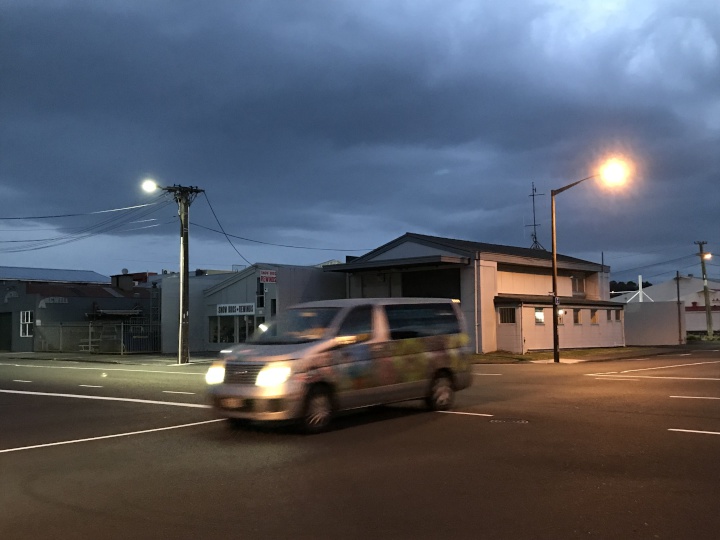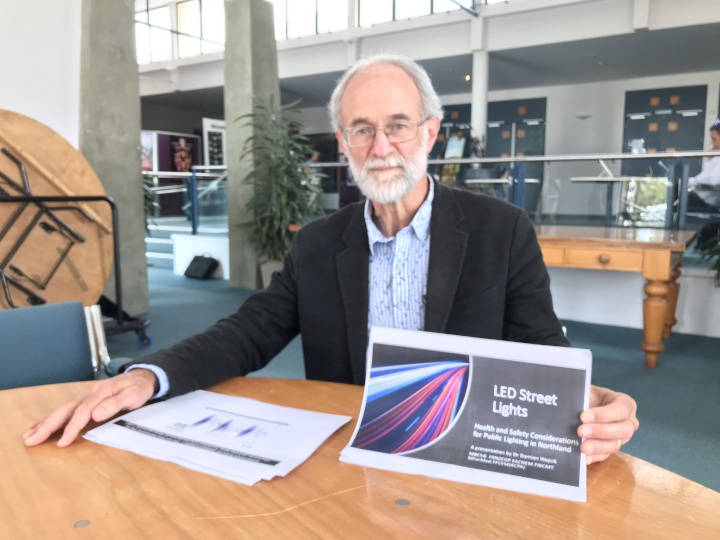A Whangarei doctor is calling for a moratorium on Northland’s $6.2 million dollar ‘street lighting technology revolution’.
Damian Wojcik, clinical director of Whangarei’s Northland Environmental Health Clinic said Northland’s three district councils should put a moratorium in place on retrofitting almost 8000 street lights with bright blue white LED lighting.

LED street light retrofitting - the bright white of a new LED-retrofitted street light (left) contrasts with the yellow glow of the still-in-place yellow sodium light at right in Whangarei's central business district. Photo: Susan Botting.
“There is major concern about the new lighting,” Damian Wojcik, Northland Environmental Health Clinic director told last week’s Kaipara District Council (KDC) meeting.
Wojcik said LED lights caused a range of health problems, with current and evolving further research demonstrating this case.
The Northland LED retrofitting, at a cost of $6,210,000, is part of the country’s national conversion of 370,00 roadside streets lights - n what key national funder the New Zealand Transport Agency (NZTA) calls a ‘street-lighting technology revolution’. The Northland conversion is almost completed.
Wojcik presented his moratorium call to KDC’s November meeting in Dargaville on Wednesday.
“When we start to replace yellow sodium lights with newer bright white lights, there are certainly problems. There are now known health effects on the radar from a number of reputable services,” Wojcik said.
One difficulty with the LED lights was the colour spectrum they occupied – a very blue and cold white light rather than the more yellow light from the previously-used yellowish sodium lights, he said.

Whangarei's Damian Wojcik - calling for a Northland councils' LED retrofitting moratorium, outside the Kaipara District Council meeting where he presented on the issue. Photo: Susan Botting.
Just over 60% of Northland’s retrofitting is in Whangarei District Council’s (WDC) rohe, home to the region’s only city. About 22% of the retrofitting is in the Far North District Council’s (FNDC) territory, whilst about 15% is in Kaipara District Council’s (KDC) area.
WDC is retrofitting nearly 5000 street lights across its territory at a cost of $3,850,000. When approached for comment in the wake of Wojcik’s moratorium call, WDC Mayor Sheryl Mai would not be drawn on whether her council would put a moratorium in place. Mai said her council had not been approached by Dr Wojcik.
KDC is LED retrofitting 1610 street lights at a cost of $1,200,000. Mayor Jason Smith, said in Dargaville after Damian Wojcik’s presentation, his council would not be stopping its LED lights retrofitting, which was largely completed.
FNDC is LED retrofitting 1700 street lights at a cost of $1,160,000. Acting mayor Ann Court said it would be highly unlikely FNDC halted its LED street lighting programme.
Court said she had never been advised of any health issues with LED lights. A national conversation about any health issues - real or imagined - from the installation of LED lights would need to happen first.
Most of the North’s $6,210,000 retrofitting is completed. Northland’s three district councils are between them converting 7810 sodium and mercury street lights to LED lighting. More than 100 different variously-sized Northland towns and settlements have street lighting, along with Whangarei, the region’s only city.
Wojcik said the moratorium should be in place until LED’s potential health risks were better understood, or technology limiting their potential impacts was put in place.
Government funding for the retrofitting through NZTA has provided 85% funding for the Northland low-energy, light-emitting diode (LED) conversions – in line with the agency’s now-five-year-old national campaign that began in Auckland in 2014.
The New Zealand Transport Agency’s website says “We’re still learning about any potential risks LEDs may bring. Some articles published internationally have resulted in a number of misconceptions about blue light in relation to road lighting. Blue light is often spoken about in terms of exposure from sources such mobile phones, computers and television.
“There is currently very limited evidence to demonstrate a significant health risk for road lighting from LED sources in relation to road lighting. A 2016 study by Public Health England has indicated reaching unsafe exposure limits for blue light risk would require someone to stare into a streetlight for 2.5 hours from a distance of two metres. Therefore, road users and pedestrians are unlikely to reach such exposure limits from LED streetlights.
Greg Monteith, Northland Transportation Alliance (NTA) capital works and procurement manager said replacing the region’s existing sodium and mercury lights with LEDs is expected to bring up to 60% power savings for Northland’s local authorities. (NZTA is a member of the alliance).
This reduced power consumption eased environmental impact and saved money.
Monteith said the LED lights had a longer life with fewer maintenance visits to replace failed lamps and equipment. LED lights lasted approximately10 years, compared with having to replace sodium lamps every five years and mercury lamps every three years.
LED lights brought road safety benefits. Human eyes were designed for white light and this type of light improved driving conditions, especially in wet weather.
They also offered a reduced carbon footprint and therefore lesser environmental impact.
Northland councils had been awarded an attractive funding package from Central Government which assisted in bringing LED lighting’s benefits to the region much earlier than would otherwise have been the case, Monteith said.
Auckland, Dunedin, Tauranga, Kapiti Coast, Wellington, Timaru and Oamaru are just some of the many places that have retrofitted LED lights under the Government-supported scheme.
In 2016, the American Medical
Association adopted guideline for communities on selecting
among LED lighting options to minimise potential harmful
human and environmental
effects.



 Howard Davis: NZSQ Inaugurates Wellington Chamber Music’s New Season
Howard Davis: NZSQ Inaugurates Wellington Chamber Music’s New Season Gordon Campbell: On The Trump Upside, And Peters Persecution Of Trans People
Gordon Campbell: On The Trump Upside, And Peters Persecution Of Trans People Binoy Kampmark: Yale, Ben-Gvir and Banning Palestinian Groups
Binoy Kampmark: Yale, Ben-Gvir and Banning Palestinian Groups Ramzy Baroud: The Myth Of Conquest - Why Gaza Will Never Be Subdued By Israel
Ramzy Baroud: The Myth Of Conquest - Why Gaza Will Never Be Subdued By Israel Binoy Kampmark: Fallibility, Dirty Wars And Pope Francis I
Binoy Kampmark: Fallibility, Dirty Wars And Pope Francis I Peter Dunne: Dunne's Weekly - An Issue No-one Can Afford To Lose
Peter Dunne: Dunne's Weekly - An Issue No-one Can Afford To Lose